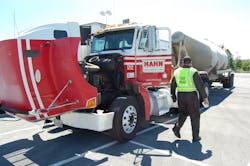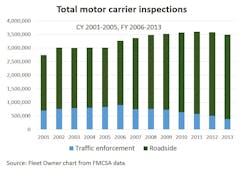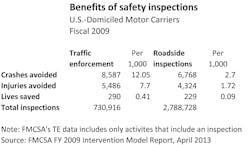Motor carrier inspections resulting from traffic stops are about four times as effective in reducing crashes, injuries and fatalities than roadside inspections (RIs) at fixed facilities, according to the Federal Motor Carrier Safety Administration, but the number of traffic enforcement (TE) inspections has plunged to barely more than half their level five years ago.
A program effectiveness report published by FMCSA in April 2013 estimates that in fiscal 2009, TE inspections avoided more crashes and injuries and saved more lives involving U.S.-based carriers than RIs – even though there were nearly four times as many RIs than TEs. FMCSA estimates that 12.05 crashes are avoided for every 1,000 TEs with inspections of U.S.-based carriers while only 2.7 crashes are avoided for every 1,000 RIs. Similarly, FMCSA says 7.7 injuries are avoided for every 1,000 TEs with inspections; 1.72 injuries are avoided for every 1,000 RIs. And 0.41 lives are saved for every 1,000 TEs with inspections while 0.09 lives were saved for every 1,000 RIs.
Inspections at weigh stations and other fixed locations have risen in every fiscal year since 2006, but after a change in the data collection methodology beginning in fiscal 2007, TE inspections peaked at 756,169 in fiscal 2008. Since then, they have plummeted, falling 48.7% to 387,804 through fiscal 2013, which ended in September of last year. And the share of total safety inspections represented by TEs has fallen from 22.3% in fiscal 2007 to 11.1% in fiscal 2013.
The Commercial Vehicle Safety Alliance (CVSA), which represents state motor carrier enforcement agencies, has questioned the accuracy of TE inspection numbers as presented on FMCSA’s Analysis & Information (A&I) Online website, but the agency has looked into these concerns and has no reason to question the data’s validity, says spokesman Duane DeBruyne.
Assuming the data is accurate, the cause of the decline in TE inspections isn’t certain. But the reduction in TE inspections does follow a change enacted by Congress in 2005 that allowed states to use funds under the Motor Carrier Safety Assistance Program (MCSAP) for motor carrier traffic enforcement activities that do not result in an inspection. So while TE inspections are declining, it’s not clear what is happening with traffic enforcement activities that don’t lead to inspections. Nor is it clear how effective traffic enforcement without inspections is relative to enforcement with inspections.
FMCSA favors traffic enforcement as a way to promote motor carrier safety.
“FMCSA keenly recognizes the importance of traffic enforcement and continues to work closely with the International Assn. of Chiefs of Police to increase officer awareness of commercial motor vehicle (CMV) safety issues and CMV traffic enforcement by all law enforcement officers – not just those with specialized CMV training and expertise,” Debruyne says. “Evidence of the success of this collaboration can be seen in IACP’s‘Interstate 80 Challenge’ that occurred in July of last year. Similar IACP-led Interstate corridor challenges will be occurring this year as well.”
A focus on traffic enforcement that doesn’t include inspections allows for greater interaction between law enforcement and motor carriers, DeBruyne says. While there are more than 500,000 sworn law enforcement officials in the United States, only about 12,000 are certified to conduct a CMV inspection.
Everyone seems to agree that encouraging more traffic stops involving CMVs is a good idea.
“Traffic enforcement is an effective way to detect and deter unsafe behaviors when and where they are happening on our roadways,” says Dave Osiecki, senior vice president for policy and regulatory affairs at the American Trucking Assns. “It’s hard to quantify, however.”
While FMCSA has data on TE inspections that can be sliced, diced and studied many ways, the agency hasn’t yet studied the effectiveness of traffic enforcement alone. One reason is that FMCSA doesn’t currently have ready access to the data.
“Data about this activity exists at the FMCSA division (state) level for the purposes of approving grant vouchers,” DeBruyne says. “It has not been rolled up on a national level.”
Beginning this year, FMCSA is working with the states to capture all CMV-related traffic enforcement conducted under FMCSA grant programs, not just traffic enforcement accompanied by an inspection.
ATA emphasizes that its bigger concern is the mix between TE inspections and RIs.
“The effectiveness of traffic enforcement coupled with some type of inspection under the MCSAP program has been quantified by FMCSA and, according to the agency, it’s much more effective than just a roadside inspection alone,” Osiecki says. “This is why ATA supports both types of traffic enforcement under MCSAP, especially if it’s coupled with inspection activity.”
A decline in TE inspections is a valid concern, “however, that’s just one component of a state’s enforcement program,” says Stephen Keppler, CVSA’s executive director. “The thing to keep in mind is that if you focused on only one input and ignore the broader picture you are not fully accounting for everything.”
He notes that FMCSA approves a commercial vehicle safety plan annually for each state.
“We need to focus on the end game and whether we are getting results,” Keppler says, adding that there are important differences among the states, including terrain, climate, population density, state laws and budgetary constraints. In many states facing budget difficulties, personnel are being redeployed and fuel needed for mobile law enforcement activities is expensive, he says.
“The right questions are being asked but we need to be careful about putting it in the right context,” Keppler says. “Each state is an individual. The federal government should not be prescribing how a state does its job. The federal government should be focused on the outputs.”
Congress may look at MCSAP as part of the highway reauthorization bill this year.
“ATA looks forward to working with FMCSA and CVSA to ensure that MCSAP resources are allocated in a manner to achieve the greatest safety outcomes,” Osiecki says.


